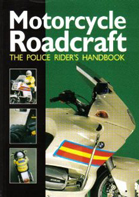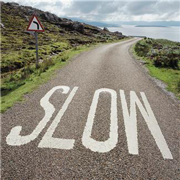RoADAR Bike Test
Information for Candidates undertaking RoADAR Advanced Motorcycle Test
This article is intended to give prospective candidates wishing to undertake the RoADAR advanced motorcycle test some preliminary advice on what the examiner will be looking for when he conducts a test. This is by no means an exhaustive list of the requirements but I hope I can give some advice and possibly point candidates in the right direction in order that they can give the best possible performance on the day.
Should you have any queries not covered by this article please take the matter up with your observer.
 Firstly the system of riding which we are looking for is that contained in the Police Roadcraft manual and the candidate should show a good practical knowledge of the contents of the manual and also be prepared to answer questions on the theoretical points covered in the ‘blue book’. The examiner will expect to see the system carried out on the approach to any hazard but he will also be looking for the candidate to demonstrate the flexibility in the system, which allows the rider to re-enter the system at an appropriate point, should the circumstances on the approach change. This is particularly important as regards signaling, as you may need to give a signal when you are part of the way through negotiating a hazard, so it is imperative that the signal is appropriate for that point in the system for that particular hazard i.e. roundabouts.
Firstly the system of riding which we are looking for is that contained in the Police Roadcraft manual and the candidate should show a good practical knowledge of the contents of the manual and also be prepared to answer questions on the theoretical points covered in the ‘blue book’. The examiner will expect to see the system carried out on the approach to any hazard but he will also be looking for the candidate to demonstrate the flexibility in the system, which allows the rider to re-enter the system at an appropriate point, should the circumstances on the approach change. This is particularly important as regards signaling, as you may need to give a signal when you are part of the way through negotiating a hazard, so it is imperative that the signal is appropriate for that point in the system for that particular hazard i.e. roundabouts.
This makes the first item of ‘Recommended Reading’ the Police Roadcraft Manual.
The main point to remember is that the riding techniques described and the system itself are a series of considerations, they are not written in tablets of stone, even ‘lifesavers’, the last look back before executing a manoeuvre, are a consideration.
The examiner (and your observer whilst under training) will want you to ignore the fact that he is behind you. Do not consider him as another road user. All of your riding plans should be based on the position and movement of other road users. This will obviously affect your decisions particularly regarding positioning and signaling. The examiner will obviously expect you to ride to a higher standard than the normal D.S.A. test and in particular to make progress where less experienced riders would not. The ROSPA test is graded, Bronze, Silver and Gold. Gold being the highest standard.
He will expect you to make progress, where it is safe to do so, by constantly looking out for opportunities to overtake or pass vehicles, which are not driving up to the speed limit, but he will not be able to condone you exceeding the speed limit. He will look for you to use situations to overtake, which other road users might not recognize as overtaking opportunities i.e. the hatched areas bordered by broken lines on the exit from a protected right turn. The examiner will expect you to demonstrate ‘filtering’ techniques, if appropriate, but if opportunities do not present themselves on test he will almost certainly ask you when it is appropriate to ‘filter’.
 If overtaking opportunities do not present themselves he will be looking for you to show that you are in fact looking for these opportunities i.e. moving up into the overtaking position, assessing the situation and dropping back if the overtake is not on. He will explain this fully on the pre-test briefing. You should be able to make progress by reading the traffic situation around you and anticipating opportunities which present themselves, for example using the most appropriate lane on the approach to a roundabout in order to pass slower moving vehicles. However you should always comply with road signing and the principles for roundabouts contained in the ‘Highway Code’.
If overtaking opportunities do not present themselves he will be looking for you to show that you are in fact looking for these opportunities i.e. moving up into the overtaking position, assessing the situation and dropping back if the overtake is not on. He will explain this fully on the pre-test briefing. You should be able to make progress by reading the traffic situation around you and anticipating opportunities which present themselves, for example using the most appropriate lane on the approach to a roundabout in order to pass slower moving vehicles. However you should always comply with road signing and the principles for roundabouts contained in the ‘Highway Code’.
The next item of ‘Recommended Reading’ has got to be the Highway Code.
The examiner will expect you to ‘straight line’ roundabouts where appropriate but on the other hand you should ‘lane’ them when you have traffic in close proximity to you on the approach, when there is traffic on the roundabout immediately to your right, or when there is traffic approaching the roundabout from any direction which may come into conflict with you on the roundabout or which may be confused by you ‘straight lining’. When you straight line a roundabout you are doing it primarily to improve the stability of your machine, it is not necessarily faster than ‘laning’ the roundabout. The speed on approach must always be such that you can negotiate the roundabout using either technique. Appropriate signals should be given for the benefit of other road users. When ‘straight lining’ you must still consider ‘lifesavers’.
You will be expected to use the cornering techniques described in ‘Roadcraft’, using the full width of the nearside of the road where appropriate, but you should always be prepared to sacrifice the position you take to improve your view for safety. When it comes to positioning the order of priority is SAFETY, then STABILITY then VIEW. You should not cross onto the offside of the road purely to improve your view, however, there are occasions where it may be acceptable to cross onto the offside of the road in order to improve the stability of your machine. Your observer will explain this technique in more detail.
The examiner will expect you to show proper use of the accelerator and brakes. You should be able to demonstrate good ‘acceleration sense’, anticipating hazards and using the throttle accurately to negotiate changing road and traffic conditions without having to resort to the brakes on every occasion.
 There will probably be at least one hill start on the test. You should always have the back brake covered when you are stationary, even on the flat, but you should show consideration for your machine by selecting neutral gear when stopped for long periods. Probably the most important aspect of advanced riding is observation. You should be constantly observing all around, in front, behind and to both sides, paying attention to the position and movement of other road users, road layout and conditions, road surface conditions, weather conditions and traffic signs. All of this information needs to be processed in order for you to plan your riding and where necessary give out appropriate signals to other road users. Pedestrians should be considered as road users, as well as vehicular traffic.
There will probably be at least one hill start on the test. You should always have the back brake covered when you are stationary, even on the flat, but you should show consideration for your machine by selecting neutral gear when stopped for long periods. Probably the most important aspect of advanced riding is observation. You should be constantly observing all around, in front, behind and to both sides, paying attention to the position and movement of other road users, road layout and conditions, road surface conditions, weather conditions and traffic signs. All of this information needs to be processed in order for you to plan your riding and where necessary give out appropriate signals to other road users. Pedestrians should be considered as road users, as well as vehicular traffic.
Consider the use of the brake light as a signal where following traffic would benefit, for example, on occasions where you can achieve your reduction in speed by deceleration and do not need to brake but following traffic needs to be made aware that you are slowing down. Always consider a shoulder check before increasing or reducing speed particularly when entering or leaving 30 mph and 40 mph speed limits.
You should always be traveling at the right speed, in the right gear, in the correct position on the road, having regard to all the prevailing road, traffic and weather conditions and you should always be able to stop safely within the distance you can see to be clear remaining on your own side of the road.
Two books that you may find useful are written by Dave Jones, a very experienced Police riding instructor. They are ‘Assessment of Advanced Motorcycling’ and ‘Not The Blue Book’. They give very good guidelines which cover the points mentioned above and are normally advertised in the various advanced motoring publications. If you have any difficulty in obtaining these publications please contact either Steve Darby or myself.
Prior to the test the examiner will need to examine your vehicle documents, he may examine your machine and he will ask you either, to go through your pre-ride checks or, ask you what checks you have done prior to your ride that day.
At the completion of the road riding part of the test, which will take between an hour and a quarter and an hour and a half over varying road and traffic conditions, the examiner will ask you questions on the Highway Code, Roadcraft and vehicle maintenance relative to your machine.
The examiner will then debrief the test and inform you of the result.
You will receive a full written report on your test, normally within a couple of weeks of taking it. If you pass at Bronze level on your first attempt you will be able to re-take your test within 12 months to try and achieve a better grade. If you pass at silver or Gold level you will be required to take further tests every three years in order to improve or maintain your advanced qualification.
Derrick Walton Motorcycle Examiner.


